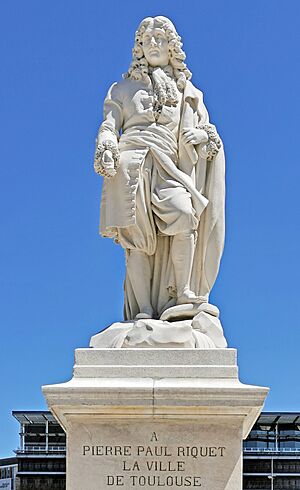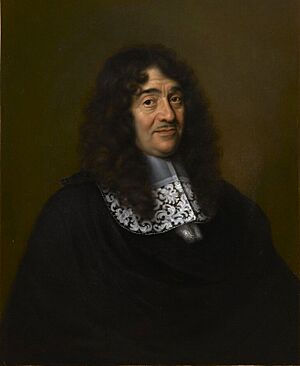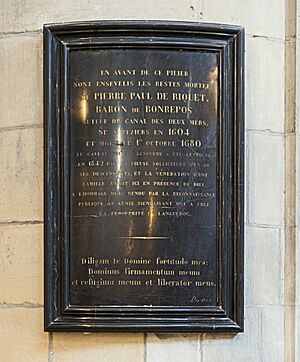Pierre-Paul Riquet facts for kids

Pierre-Paul Riquet was a brilliant engineer and canal-builder from France. He is most famous for creating the amazing Canal du Midi, a huge waterway that connects the Atlantic Ocean to the Mediterranean Sea. Riquet was born on June 29, 1609, and passed away on October 4, 1680.
Contents
Riquet's Early Life
Pierre-Paul Riquet was born in Béziers, a town in France. His father, Guillaume Riquet, was a lawyer and a businessman. From a young age, Pierre-Paul loved mathematics and science. These subjects would become very important later in his life. He married Catherine de Milhau when he was 19 years old.
Riquet became very good at managing money and projects. He worked as a "tax farmer" (called a fermier général). This meant he collected taxes for the king, especially a tax on salt called the "gabelle." He started this job in 1630. This work helped him become very wealthy. His wealth and skills allowed him to plan and build big projects that needed a lot of technical knowledge.
Building the Canal du Midi
Riquet's biggest achievement was building the Canal du Midi. This amazing artificial waterway is 240 kilometers (about 150 miles) long. It connects the south coast of France to the city of Toulouse. From Toulouse, other canals and rivers link to the Bay of Biscay on the Atlantic side. This canal was one of the greatest engineering feats of the 17th century!
The idea of building such a canal had been discussed for a long time, even by the ancient Romans. But it was a very difficult project to plan and build. King Louis XIV really wanted the canal built. Shipping goods around southern Spain was becoming too expensive and dangerous because of pirates.
Challenges and Solutions
Building the Canal du Midi took up all of Riquet's time and money starting in 1665. There were many huge problems to solve.
- Hills: How do you build a flat canal through hilly areas?
- Water Supply: How do you keep the canal full of water during dry summer months?
Riquet and his team found clever solutions. They used new ideas for canal locks. Locks are like water elevators that raise and lower boats between different water levels. They also created a huge artificial lake called the Bassin de St. Ferréol. This lake could hold 6 million cubic meters of water! It collected water from streams in the Montagne Noire (Black Mountain) and fed it into the canal.
Riquet's Legacy
The cost of building the canal was enormous. It used up much of Riquet's personal fortune. Even his sponsors, including King Louis XIV, started to lose interest because of the many problems. But Riquet kept going!
Some of his most impressive engineering achievements include:
- The Fonseranes Lock Staircase: A series of connected locks that raise or lower boats a great distance.
- The Malpas Tunnel: The world's first navigable canal tunnel, meaning boats could travel through it!
The Canal du Midi was finally finished in 1681. Sadly, Pierre-Paul Riquet passed away in 1680, just eight months before his great project was completed. He is buried in the Cathedral Saint-Etienne in Toulouse. His work changed trade and travel in France forever.
Images for kids






